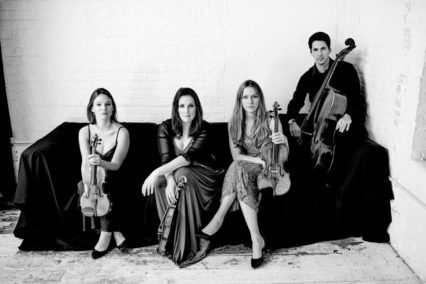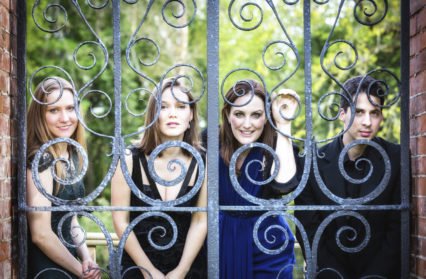Nigel Jarrett attends a performance by The Albion Quartet at the Dora Stoutzker Hall at the Royal Welsh College of Music and Drama and offers a thoughtful review of the night.

Musical residencies say a lot about the residents and where they reside. The renown of the RWCMD and the high calibre of the Albion Quartet, which is not bound by just its Cardiff duties, indicate how far is the college’s reach and how willing the busy Albion is to be associated with it to mutual advantage. The quartet made its double-debut at the Amsterdam Concertgebouw and in Paris at the Auditorium de Louvre just two years old. It’s also resident at King’s Place in London, was due to be quartet-in-residence at the Stratford-upon-Avon Festival of Words and Music before this year’s event was cancelled due to a funding shortfall, and is already preparing to record for the Signum label over the next few years the string quartets of Dvořák and quartets by Walton and Britten. Britten’s second quartet of Op 36 formed the second part of this animated lunchtime recital.
The passion of The Albion Quartet erupted at the start of Beethoven’s quartet No. 11, the last of the composer’s ‘middle’ period quartets that include the three so-called ‘Rasumovskys’ and appearing to foreshadow the ‘late’ period, in which the quartets are like nothing else in the genre. But there are always connections in music, not least between composers and their predecessors. The links between the F minor quartet and the middles and lates are less easy to establish: whereas the elaboration of form in its forerunners and successors is part of their attraction, the transition quartet is almost a model of concentration and insularity. For Beethoven, it was the ‘Quartet Serioso’.
The Albion was certainly serious about the work’s intemperate mood from the start and keen to emphasise the opening movement’s way of raising expectations and then dashing them, as in the final episodes, where one would normally look forward to more music but is denied. It’s commonly the shortest opening of the Beethoven quartets, timed here, just as a diverting exercise, to just short of five minutes. Throughout, even in the Allegretto, which seems to offer a respite from the turmoil, the Albion was keen to get on with things, relishing the return of the inconclusive mood and continuing to pursue the work’s inherent restlessness. It threw itself into the music almost literally, sometimes with aggression, as in that opening, where Beethoven’s score marking had seemed like a guide rather than an imposition. Whether or not there and elsewhere it bordered on the indisciplined was a matter of taste, but it was certainly unambiguous in a work full of ambiguity, not least at the very end, where least expected of all after such relentlessness, a lighter mood is established.
Nor was the performance of Britten’s second quartet any less committed, although its demands are for an acknowledgement of ancient and modern in its homage to Purcell. The work was premiered in 1945, precisely 250 years after Purcell’s death. The Albion did not entirely release itself from Beethoven’s perturbation of spirit to embrace the unequivocal spaciousness and invention of Britten, but it was fully attuned to the work’s originality, which marks it as a significant work in 20th-century quartet writing. It had the measure of Britten’s euphony, particularly its delight in the string writing, which is often startling in its pursuit of delicacy and almost orchestral power.
Once the first movement of The Albion Quartet was underway in almost narrative form the musicians were geared to combining the various themes in its climax. The middle movement’s scherzo was buoyant, its trio section finding leader Tamsin Waley-Cohen in lascivious form with those double-stops above the accompaniment of the other three musicians – Emma Parker (second violin), Rosalind Ventris (viola) and Nathaniel Boyd (cello) – and joining them with enthusiasm in the return to the propulsive scherzo. The final movement is awesome, Britten calling it a Chacony, the term Purcell used to describe a variation movement akin to the Italian chaconne. The Albion was ultra-attentive to the demands of the movement’s ingenious character: no fewer than 21 variations in sets separated by cadenzas from cello, viola and first violin. Those final C major chords of the last variation were compelling, if not quite capturing the grandeur they might suggest to some listeners.
The Albion’s enthusiasm is infectious, its rise to prominence in just two years remarkable. In a field where ensembles, as a rule, take time to achieve maturity, its playing has the lustre of the new, though not yet, for obvious reasons, the mellow consideration of the long-established. But it will come, perhaps as quickly as the attention, it has attracted on its arrival and with no loss of that early sparkle.
The Dora Stoutzker Hall is part of the Royal Welsh College of Music and Drama which offers a variety of performances and productions.
Nigel Jarrett is a writer and critic and a former daily-newspaper journalist. He won the Rhys Davies Prize for short fiction and the Templar Shorts Prize. He has published a novel; a poetry collection; and two volumes of stories, the first, Funderland, being praised by the Guardian, the Independent, the Times and several more. He was formerly music critic of the South Wales Argus and now writes for Wales Arts Review, among others.
Header photo by Patrick Allen



 Enjoyed this article? Support our writers directly by buying them a coffee and clicking this link.
Enjoyed this article? Support our writers directly by buying them a coffee and clicking this link.







